Midsummer to-do list
🪴 Did you plant hardy perennials in your planters? Begin identifying a permanent location in your landscape for potted perennials that you plan to grow in your garden beds.
A container grown perennial’s best chance for winter survival depends on not fertilizing it after early August.
Plan to transplant container grown perennials into garden beds while soils are still warm – typically early to mid-September is recommended, however, that is not a hard and fast rule.

Coral bells in a planter will be lifted in the fall and planted in the garden. (Colleen Zacharias)
I have hastily emptied containers in October and installed hardy perennial plants in October and been relieved to discover the following spring that they made it through the winter.
You will have fewer worries, though, if you get perennials into the ground by mid-September!
🧄 It’s time to grow amazing garlic. John Boy Farms, located near Ste. Agathe, is a six-generation family farm that specializes in growing more than a dozen varieties of vigorous cold-hardy seed garlic varieties.
Jean-Guy Cote, who manages the farm with his wife Ainsley, is an agronomist with a Bachelor of Science degree in agriculture. Cote has spent many years researching the best methods to grow garlic. You will find excellent information on his farm’s website about choosing garlic seed as well as tips on planting, harvesting, curing and storage.
Cote has written a comprehensive guide, The Master Guide To Growing Big Garlic, which includes detailed advice including illustrations, on how to grow amazing garlic. It is available as an e-book for $24.95.
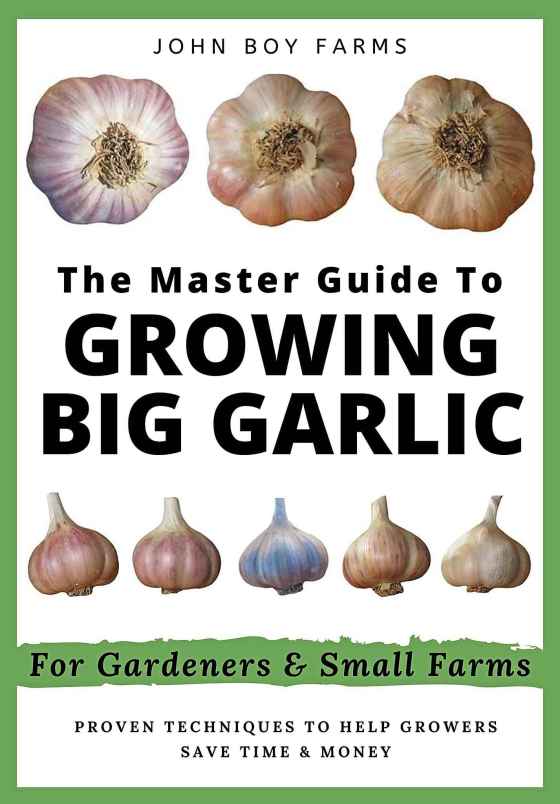
The Master Guide to Growing Big Garlic.
Planning to plant garlic this September? John Boy Farms begins shipping garlic orders after harvest in early to mid-September. Visit the website or email johnboyfarms@gmail.ca.
⚫ Plastic nursery pots still kicking around? Empty out any soil or debris, give them a quick rinse with your garden hose, and drop them off at a local greenhouse that accepts nursery pots for recycling.
Some restrictions may apply; branded pots or pots from plants purchased elsewhere may not be accepted – check with your garden centre.
But do keep plastic nursery trays that hold plant pots, if you have space available. These will come in handy next spring for transporting all your new plant purchases indoors and outdoors until you are ready to begin planting.
✂️ Deadhead vigorous self-seeders like Lady’s Mantle and Brunnera. These durable low mounding perennials are typically planted in borders. Now is the time to remove spent sprays of flowerheads before they self-seed into adjacent lawn or between paving stones.
🫘 Start saving seeds. Seeds of Diversity reminds gardeners to allow some pods on your green beans and peas to mature until they produce seeds that you can collect for growing next year.
Leave some of your flowers to age on plant stems so you can collect their flower seeds in fall for replanting next year.
🌊 Last but not least, continue to water newly planted trees and perennials on a weekly basis.
Have you seen this bug?
This insect was spotted in a St. Vital garden, and I was not familiar with the name of this unusual bug.
I forwarded the images to Dr. Jason Gibbs, associate professor in the department of entomology at the University of Manitoba. The department offers to identify insects for Manitobans via its Bugline.
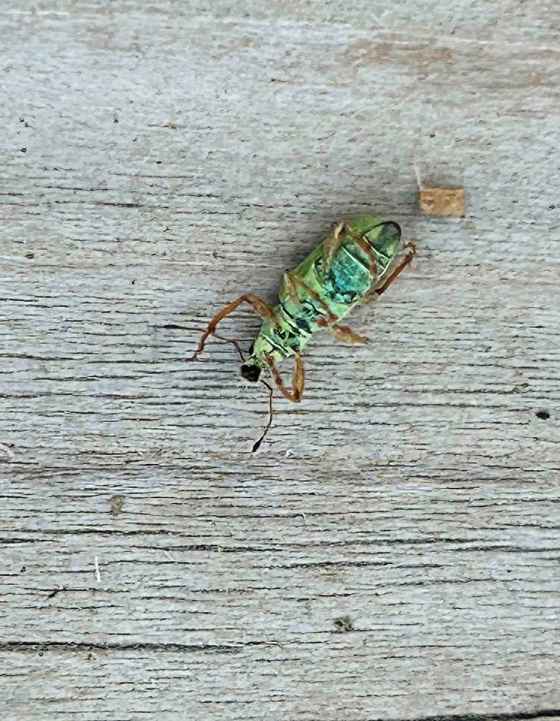
Polydrusus impressifrons (Susan Southern)
“This is Polydrusus impressifrons,” replied Dr. Gibbs. “It’s an introduced weevil from Europe. They feed on various trees.”
Note the linear ridges on the wing coverings. The adults grow to a mature size of 3.8 to 5.6 mm. Polydrusus impressifrons is classified as a broad-nosed weevil.
It chews on the leaves of birch, maple, willow, and poplar trees but will also feed on fruit trees, strawberry plants and rose shrubs. The larvae feeds on roots. Polydrussus impressifrons is not considered a serious pest, but nor is it considered a beneficial insect.
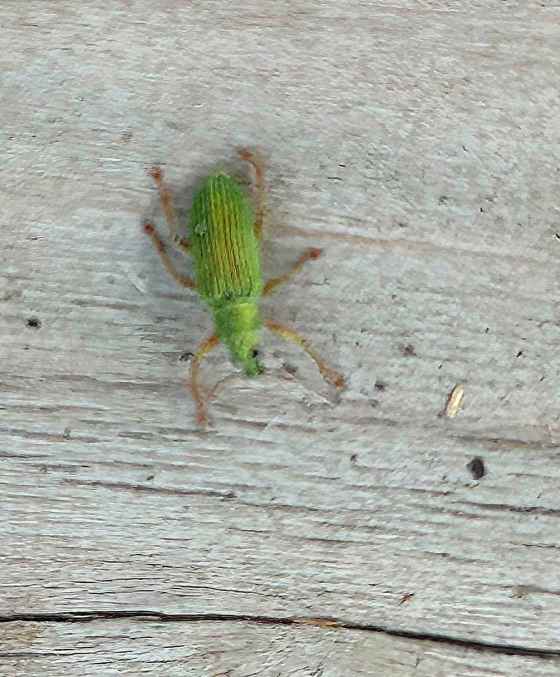
Polydrusus impressifrons (Susan Southern)
Also known as the leaf weevil or pale green weevil, Polydrussus impressifrons was introduced to North America in the early 20th century. I have never encountered it in my garden. Have you? Reply to let me know.
Growing gorgeous dahlias
Heather Warkentin owns Prairie Grove Acres, a family-run farm near Domain, Man., that grows and sells dahlia tubers. Here, Warkentin answers some commonly asked questions about growing dahlias.
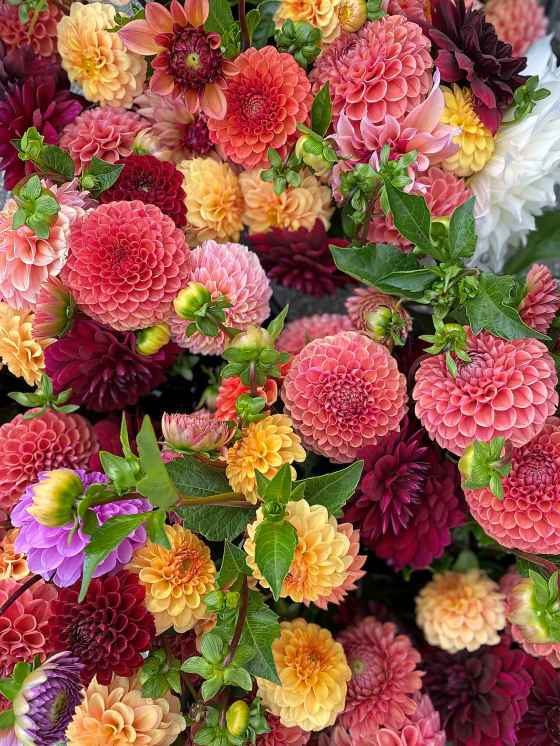
Popular colours of dahlia. (Prairie Grove Acres)
What are some of the key factors in August to growing great dahlias?
August is the time that dahlias start to really take off and we see the rewards of our labour and finally get to enjoy some blooms.
As plants start to bloom, they often start on shorter stems, so deadhead blooms to encourage more blooms.
If you just want to enjoy them in your garden, and not use as a cut flower, deadheading is still important as you want to have blooms for as long as possible. If you don’t deadhead, the plants will put energy into seed production rather than new blooms.
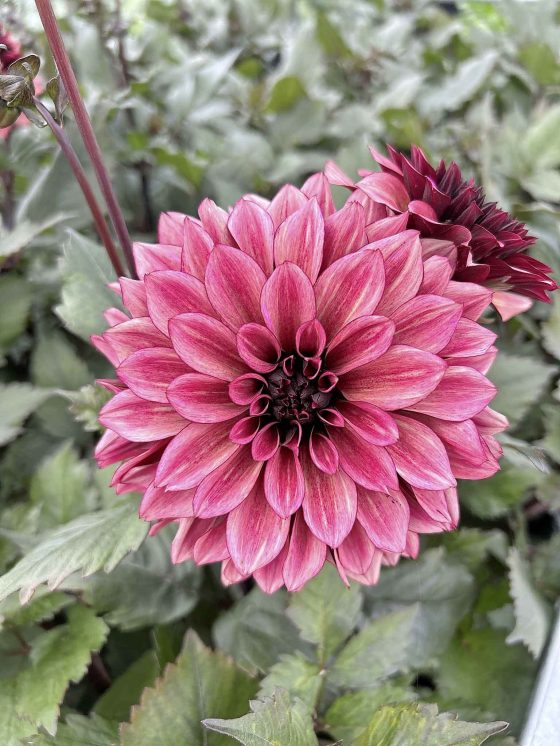
Dahlia Night Silence, most requested for tuber sales. (Prairie Grove Acres)
In August, the plants are quite large so watering deeply and consistently is important. We should also still be seeing hot temperatures so keeping the plants hydrated is important.
At Prairie Grove Acres, we are still fertilizing, but we use a lower dose and we keep nitrogen to a minimum. We also remove lower leaves from the plants at this point to allow for better airflow.
What to do about powdery mildew?
Powdery mildew is a problem in areas that are humid with poor airflow. We tend to act on the prevention side and have had success so far and it hasn’t been a problem for us.
We use drip irrigation to not get the foliage wet. If you have a smaller garden and hand water, make sure you are watering at the base and not spraying the whole plant.
It is preferable to water deeply and less often, then allow the soil to dry out before watering again, rather than overwatering and always having the ground wet.
Water early in the day to allow the plant foliage to dry before the coolness of night, when it would stay damp.
Again, we remove the lower leaves of the plants to promote better airflow. We also make sure we have good spacing between our rows for better airflow.
Our dahlias are planted in the field where they get full sun, so adequate sunlight is also important.
If powdery mildew does occur, ensuring you are doing all of the above is important. Remove affected leaves and dispose of them, and if necessary, you may need to use a fungicide or some other home remedy. I have heard a milk mixture can work well but luckily, I have not had to try it.
Which dahlia variety was your top seller in 2025?
Our most requested dahlia in tuber sales is always Night Silence. Our top sellers as a cut flower are always dahlia varieties in shades of pinks, peaches or corals.
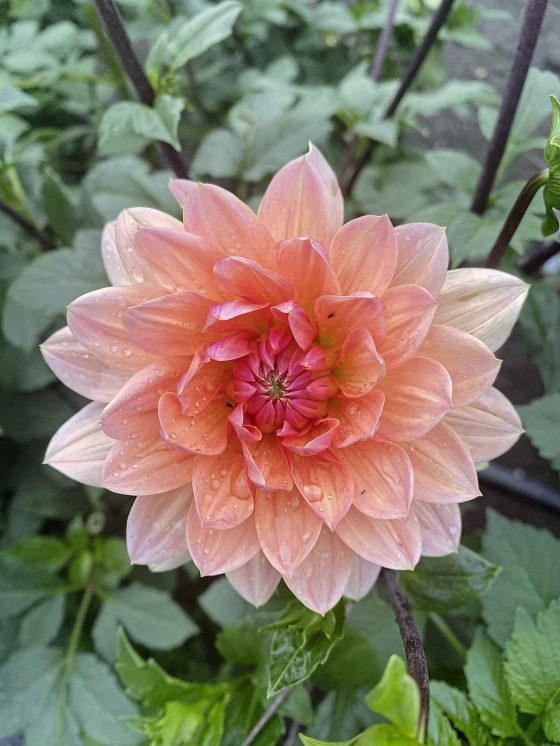
Apricot Desire, the most-wanted dahlia for weddings. (Prairie Grove Acres)
Since dahlias are a late-season crop, all the deep fall tones (burgundy, bronze, orange) are always a hit.
Dahlia Apricot Desire always seems to be requested for weddings.
Any tips for harvesting and cutting dahlia flowers?
We cut our dahlias in the morning, when the temperature is still cool, to prevent stress on the plants.
Cut dahlias when they are pretty much fully open as they do not open further once cut.
Check the outer petals to ensure they are not wilting, damaged or browning as these are signs that the dahlia is past its prime.
When cutting dahlias, always cut deep, just above a node or set of leaves. At first this feels like you’re cutting half the plant away, however, this will encourage new shoots and blooms and in no time your plant will be bushier with more stems for cutting and enjoying.
After cutting the stems, remove any leaves that will be sitting in water to prevent bacteria growth in the vase.
Keep zinnias looking fresh
Marianne Bergmann, flower farmer, owns The Garden Path Flowers, a seasonal flower farm located at 1859 Lord Selkirk Highway, near Glenlea.
Specializing in cut flower bouquets and dried arrangements, The Garden Path Flowers is the longest-running flower farm in Manitoba, now in its 29th season.
I asked Bergmann to name her favourite series of zinnias and to share tips on how to make zinnias bloom more.
“My favourite tried and true varieties of zinnias are Benary Giant and Oklahoma series,” says Bergmann. “I grow about 35 different colours and varieties of zinnias, but Benary Giant and Oklahoma zinnias are the best producers.
“Floret Flowers in Washington has come out with its own line of zinnias and while I love some of the colours, I have found the seeds are somewhat inconsistent when it comes to colour and don’t have great stem length. I’m fussy though. A lot of people really love Floret’s zinnias.
“My best tip for maximizing zinnia blooms is cutting them. The more you cut, the more they bloom. I also think most people should grow them from seed as zinnias don’t like to be transplanted. I do both and the ones I start in the greenhouse and baby for about a month are only about a week earlier than the ones I direct seed.
“Zinnias will bloom until frost. Cutting them regularly just ensures that the blooms are new and don’t look weathered.”
You’ll find Bergmann’s display of farm fresh field-grown zinnias and mixed flower bouquets at the St. Norbert Farmer’s Market every Saturday until frost or Thanksgiving — whichever comes first!
Game Changer hydrangea
I am growing Game Changer hydrangea this summer and am both mystified and enchanted by this new introduction.
First, it must be stated up front that Game Changer Hydrangea is not hardy to Zone 3b. Rated as hardy to Zone 5a (-26.1 C), the Game Changer series of hydrangeas is a variety of Hydrangea macrophylla and is meant to be grown in a planter for a single season.

Game Changer hydrangea: a change of scene for more flowers (Colleen Zacharias)
What makes it so magical?
The voluminous size and the arching habit of this new hydrangea’s long, sturdy stems with their large, pointed green leaves make Game Changer well-suited to hanging baskets or as a standalone plant in containers.
The lacecap flowers – at all their different stages – are beautiful. At first, small clusters comprised of tiny buds appear. The cluster begins to expand in size as the outer ring of creamy white, sterile flowers start to open.
Gradually, the white flowers open fully, and the entire cluster expands to 24 cm across (yes, I measured). As the flower ages, the inner fertile flowers transition to a dusty rose colour.
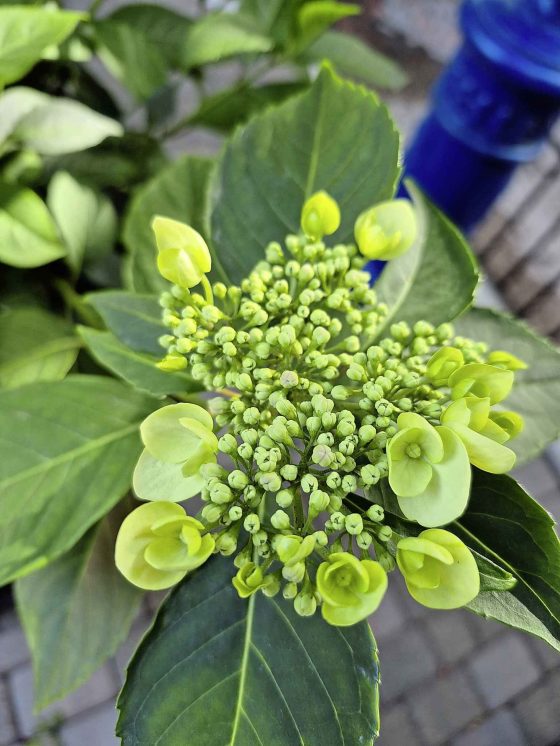
Lacecap flower bud on the Game Changer hydrangea (Colleen Zacharias)
What’s the mystery?
Trying to establish the ideal light conditions for Game Changer to pump out the maximum number of blooms has been a challenge.
The plant tag for Game Changer recommends a full sun location, however, long exposure to the hot prairie sun is typically too intense for macrophylla hydrangeas and results in leaf scorch and wilting.
That said, a shady location or a location that provides only morning sun is not adequate to promote rebloom.
Since moving Game Changer hydrangea from a leafy location in my front yard, where it received only morning sun and shade for the remainder of the day, to a new location at the edge of my backyard patio, where it now receives consistent bright light throughout the morning followed by a few hours of direct sunlight in the early part of the afternoon, I now have 11 buds on one of my Game Changer plants.
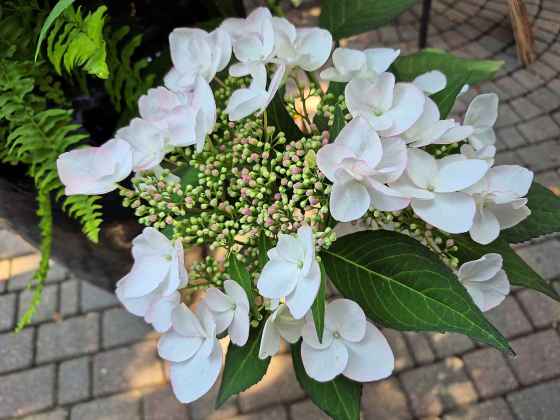
An extra-large flower cluster on the Game Changer hydrangea (Colleen Zacharias)
Bottom line: The right light conditions make all the difference in a plant’s performance. Sometimes, it’s through trial and error that gardeners determine the ideal light conditions for a new shrub or perennial that has not been trialed in our tough prairie environment. Container gardens which are moveable feasts make the task easier.
Will I grow Game Changer hydrangea again next year? Oh, yes!
2026 Perennial of the Year
Proven Winners has named Astilbe Dark Side of the Moon as its choice for 2026 Perennial of the Year.
Introduced in 2023, this compact astilbe (51 cm tall) has distinctive deep chocolate brown fern-like leaves and rosy purple flowers. New foliage starts out with a yellow tint before turning completely dark.
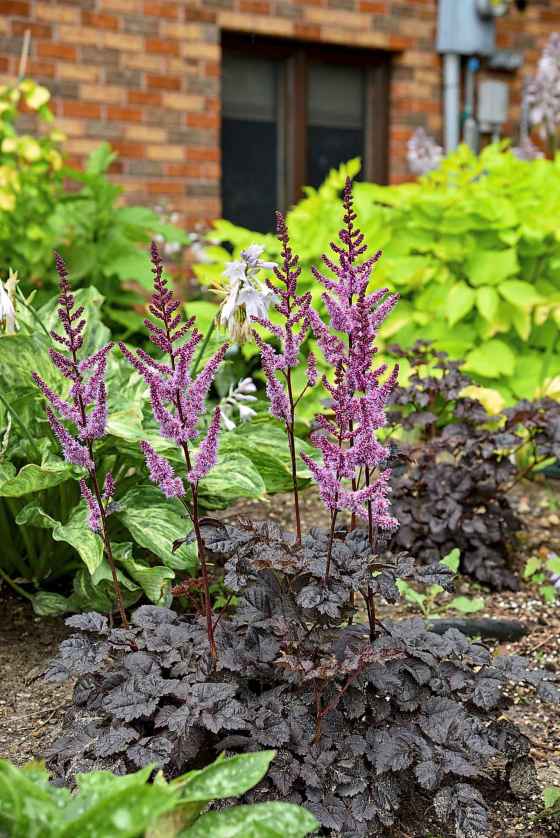
Astilbe Dark Side of the Moon (Proven Winners)
Rated as hardy to Zone 4a, Astilbe Dark Side of the Moon has demonstrated superb cold hardiness in many local gardens. I purchased mine locally and it has overwintered twice in my garden.
It is recommended to plant Dark Side of the Moon in sun or shade. I planted in both exposures and found a part-shade location to be ideal. In full sun, Dark Side of the Moon’s leaves scorched along the edges.
For vivid contrast, consider planting Dark Side of the Moon near the front of a border against a backdrop of Aralia Sun King, which has bright chartreuse leaves. It also combines well with the velvety texture and mounding habit of Lady’s Mantle.
Look for Astilbe Dark Side of the Moon at your local garden centre this summer.
Gardeners in a dangerous time
Gardening can be a hazardous sport: trips and spills, bug bites, aching muscles, sunburn, and extreme heat are just some of the calamities that call for a conscious and intentional approach to our favourite activity.
But as the intensity and frequency of wildfires increase, gardeners face a new challenge: the health risks of wildfire smoke. The 2025 growing season has already experienced more than two dozen days with air quality alerts, along with numerous days with high to very high health risk warnings.
Jane Seniw, a Winnipeg Gardener reader and Garson-area licensed arborist, is concerned about the forecast for wildfires to extend into fall and the potential impact on gardeners and others in the horticulture sector.
“There are more health risks to come, especially to those who work outside – tree nurseries, arborists, market gardeners, farmers, etc.,” says Seniw.
Researchers are learning more about the health effects on the lungs of the finer particles in wildfire smoke.
This table shows a summary of current the air quality health index values and forecast maximums for locations around Manitoba.
Create an illusion
Mirrors, window frames – even vintage iron grates – can be used as a design tool in your garden to create the illusion of more space.

A gate with a vintage grill. (Colleen Zacharias)
Hang a mirror on your fence or lean one against a sturdy support to reflect light in an otherwise dark or nondescript space in your garden. You can also position it to reflect a colourful plant display.
Choose a mirror with a frame that is made from a durable material such as weathering steel, tin or other metals such as brass or bronze that will withstand the elements year-round.
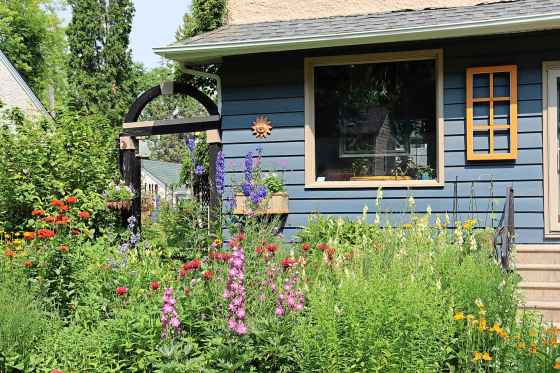
A salvaged window frame adds charm. (Colleen Zacharias)
A wooden picture frame, salvaged window frame or moss-covered frame can also be used to create the illusion of more space or to give added whimsical dimension to an outside wall. Keep in mind, though, that wooden garden decor will deteriorate over time from exposure to rain or snow and will last longer if it is protected with a weather-resistant sealant and stored indoors for the winter.
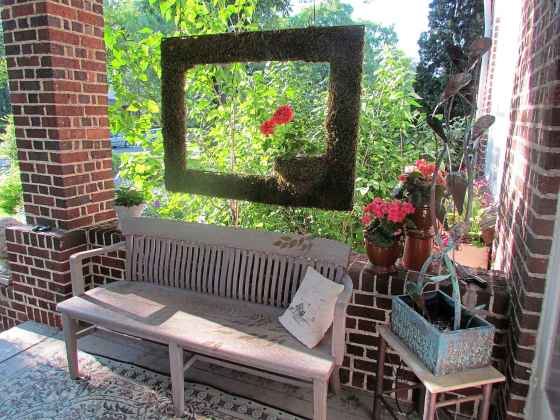
Create an illusion with a moss window frame. (Colleen Zacharias)
Funky, repurposed items such as a vintage iron floor grate installed in a gate provides a window on the world while introducing extra light into your garden space.
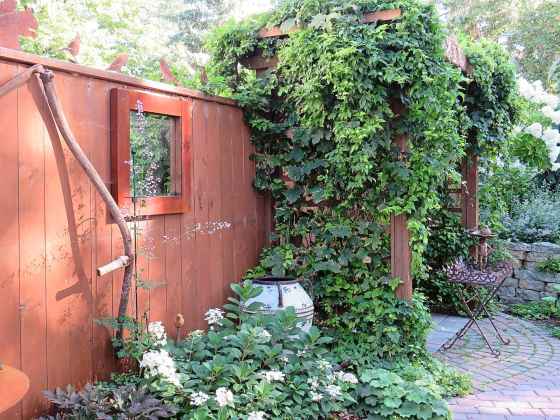
Mirror, mirror on the wall. (Colleen Zacharias)
What’s your inspiration for creating an illusion in the garden?
Red and white fervor
In last month’s newsletter, we highlighted red-and-white themed container gardens and invited readers to share photos displays.
Bev Born is a balcony gardener who lives at the Enclave Residences in St. Vital. “Our balcony faces south and west, top fourth floor with no overhead cover, so lots of heat and sun. I searched for flowers that were full sun and heat tolerant.
“Usually I plant lantanas but could not find red and white. My husband Brian takes of the daily watering and sometimes (waters) twice,” saves Born.
Born planted eight containers with red and white flowers. She traveled to Selkirk specifically to purchase Verbena Voodoo Red Star from The Flower Child Garden Centre in Selkirk after reading about this unique verbena in my column.

Bev Born’s red-and-white themed balcony garden. (Bev Born)
Here is the full list of plants and combinations that Bev Born purchased for her balcony garden:
- Bracteantha Dreamtime Jumbo Red,
- Diamond Snow Euphorbia and Lanai Upright Scarlet Verbena (in a hanging container on the railing),
- Lanai Upright Scarlet Verbena and Lanai Upright White Verbena (in hanging container on the railing),
- Red Rio Dipladenia and Double White Calibrachoa,
- White Rio Dipladenia and Deep Red Calibrachoa,
- Empress Flair Dark Red Charme Verbena and Diamond Snow Euphorbia,
- Verbena Voodoo Red Star (three plants),
- Brillant red hibiscus for table.
Born’s balcony garden also includes 12 containers of herbs for a beautiful, lush display.
Native plants: a growing trend
Local native plant nurseries are enjoying a banner year as demand for native plants continues to surge.
Customers are interested in the environmental and ecological benefits of native plants. Drought tolerance, benefit to pollinators, ease of maintenance and disease resistance are key factors in the decision to grow native plants.
To find out what’s driving sales of native plants in North America, read the 2025 Native Plant Market Report in Nursery Management.
Aimee McDonald, co-owner of Prairie Flora Greenhouse near Teulon, has seen growing demand among her customers for native plants.
“We had the highest demand this year for Echinacea purple coneflower, followed by wild bergamot, three-flowered avens and pussytoes (Antennaria parvifolia),” says McDonald.
“We had much higher than usual demand for purple prairie clover and showy goldenrod. They reached our top 10. These two are usually underappreciated perennials so it’s nice to see them get noticed!
“Also, grasses were in more demand than usual this year, which is great to see since they are such an important part of the landscape.”
Spotlight on West Broadway
This summer, the West Broadway Community Organization in inner-city Winnipeg is offering an exciting lineup of workshops and events for people who want to learn about gardening.
“Gardening-related workshops and activities are important to the West Broadway Community Organization,” says Kelly Frazer, executive director, “because they can provide community members with the skills and knowledge to grow their own food. This contributes to community food security, while also facilitating a shared activity that can help build relationships between people in the neighbourhood.
“Learning often comes with sharing, so workshops and activities encourage people to share knowledge about gardening, including ways to preserve and use food, or to share stories about lessons learned and personal experiences.
“Because we have a strong community of gardeners in West Broadway, many of whom utilize WBCO’s four community gardens located throughout the neighbourhood, our organization strives to amplify the joy, knowledge, and community that gardening fosters.”
There is a central focus on weekly permaculture workshops with Audrey Logan, a traditional ecological knowledge keeper.
“To have a garden so deeply committed to indigenous permaculture practices is an honour,”says Frazer. “The weekly permaculture gardening workshops serve as a regular opportunity for community members to get involved, learn about permaculture gardening and to build relationships.”

A gardening workshop by the West Broadway Community Organization in the park near the Broadway Neighbourhood Centre. (WBCO photo)
The events are free, and everyone is welcome to attend. Here is what WBCO has in store for August:
Sundays in August: Permaculture Gardening Workshops and Planting Ojibwe – Language and Knowledge Sharing, 10 a.m. to 11:30 a.m. at Spirit Park, 200 Young Street.
Wednesday, Aug. 6: Growing Edible Plants in Pots, 4 p.m. to 5:30 p.m. at the West Broadway Farmers Market, 185 Young Street. Bring your own container to take home some free potting soil and herbs.
Thursday, Aug. 7: West Broadway Tree Walk, 6:30 p.m. to 7:30 p.m., meet at 185 Young Street.
Wednesday, Aug. 13: Accessible Gardening, 4 p.m. to 5:30 p.m. at the West Broadway Farmers Market, 185 Young Street. Learn about how people with a variety of mobility challenges can make gardening physically easier and safer.
Wednesday, Aug. 20: Planting for Pollinators, 4 p.m. to 5 p.m. at the West Broadway Farmers Market, 185 Young Street. Learn how to benefit pollinators, including how you can garden to maximize pollen sources.
Thursday, Aug. 21: West Broadway Gardens Tour. Meet at 748 Broadway at 4:45 p.m. for a tour of the West Broadway neighbourhood gardens! Meet community gardeners and see the beauty in all corners of the neighbourhood. Light refreshments will also be provided.
Sunday, Aug. 24: Sage harvesting workshop, 9 a.m., meet outside 560 Broadway. Learn how to harvest and care for the sage that is growing right on neighbourhood streets.
Wednesday, Aug. 27th: Fermented vegetables workshop, 4 p.m. to 5 pm at the West Broadway Farmers Market, 185 Young Street.
Mark your calendars
On Aug. 8 and 9, the St. Vital Agricultural Society will host its 114th Annual Fair and Display at the St. Vital Centennial Arena, 580 St. Anne’s Rd. A great lineup of vendors and information booths awaits you along with a Friday night dinner, Saturday morning pancake breakfast and lunch hosted by Winnipeg South Lions Club. There will also be floral demos by Debbie Innes and Esther Chen of Pick-a-flor and entertainment on Friday evening by Tom Racine. More details here.
The Miami Horticultural Club invites you to attend their annual show on Thursday, August 21 at the Miami Community Centre Hall, 34112 Highway 23.
Judging begins at 9:15 a.m. and the show opens to the public at 3 p.m. There will be more than 600 classes including cut flowers, house plants, vegetables, fruit, photography, arrangements, flower and plant specials, fruit and vegetable specials, stepping stones, and planters.
Entries can be brought in Wednesday evening from 7:30 to 9 p.m. or Thursday morning from 8 to 8:45 a.m., with judging starting at 9:15 a.m. Show books can be found online.
|

